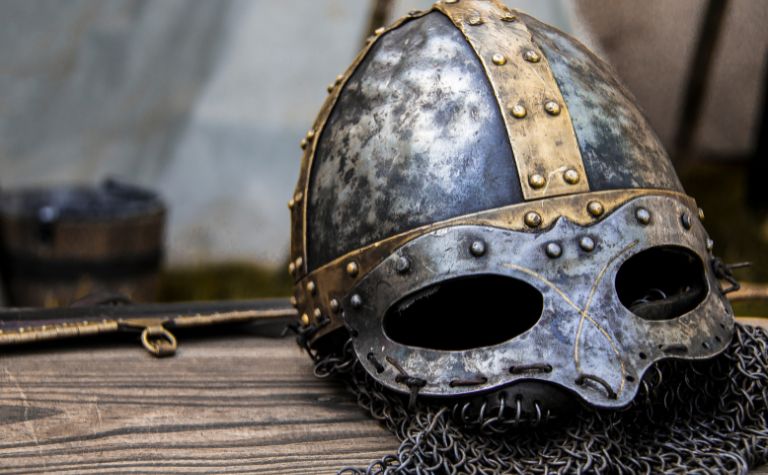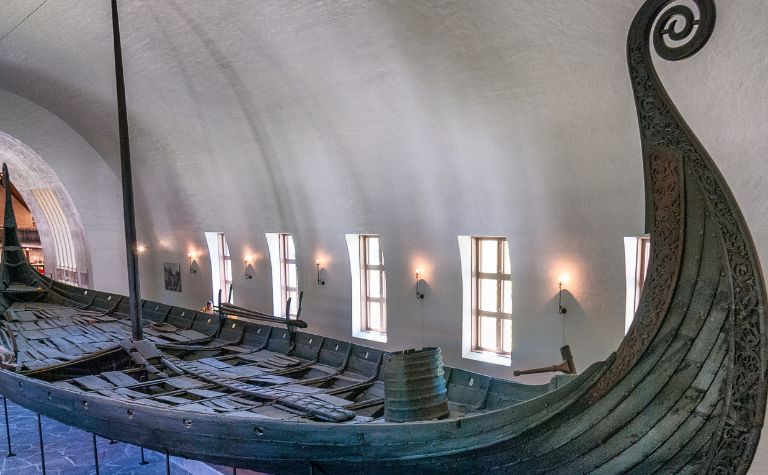In the collective imagination, the Vikings were famously pagan. This information is only partially accurate, as most Vikings had converted to Christianity by the close of the Viking Age.
However, the early Vikings’ pagan religion does not imply that their advent was before that of Christ.
The Vikings came after Christ in historical chronology.
Jesus Christ is believed to have been crucified by 30 A.D. at the latest, whereas the Viking era did not begin until 793 A.D., over seven centuries after the death of Christ.
By this time, much of Western Europe was already Christian.
This article will provide an overview of the timelines of the Viking Age and the life of the historical Jesus and explain the Vikings changing relationship with Christianity over time.

Overview of the Vikings: Timeline
The Vikings were a Norse people based primarily in the present-day Scandinavian countries of Sweden, Denmark, and Norway.
They were advanced shipbuilders, adept navigators, and avid explorers of the seas, traveling further than any other people of their time.
Although the Norse were also farmers and craftsmen in their own right, they took to piracy in large numbers at some point in time.
Scholars posit that the limited availability of resources in their homelands drove this turn.
Eventually, Norsemen who took up piracy became known as Vikings, after the Norse word for pirate.
As Vikings did not keep written records of their exploits, their era is usually marked based on the accounts of their victims, many of whom did maintain such accounts.
Fortunately, there is no shortage of accounts of the Vikings by:
- Contemporary English chroniclers
- French chroniclers
- Arab chroniclers
These surviving testimonies trace the beginning of the Viking Age to 793 CE when the Vikings raided a monastery at Lindisfarne on the north-eastern coast of England.
This does not mean that Vikings did not exist before this date, only that there is no known record of them any earlier. [1]
Later, Viking parties repeatedly raided towns and cities all over Europe, looting and plundering everywhere they went.
Over three centuries, they colonized large parts of present-day France and England and voyaged as far as Constantinople in present-day Turkey and Newfoundland in present-day Canada. [2]
But the Vikings weren’t merely pirates and raiders.
As mercenaries and traders, they established cooperative relations and alliances with many of the kingdoms they came into contact with.
Eventually, the Vikings gave up their nomadic life, settled in different parts of Europe, and merged into local populations. [3]
In 1066 A.D., the Norman descendants of the Vikings defeated the Anglo-Saxons at the Battle of Hastings and established their hold over England.
Scholars today recognize this event as marking the close of the Viking Age.

Overview of the Life of Christ: Timeline
Jesus of Nazareth was a first-century A.D. Jewish prophet from Galilee in present-day Israel.
Also known as Jesus Christ, he is the central figure of the Christian church, the largest religious organization in the world.
Devout Christians believe he is the Son of God who died to redeem them of their sins.
There is plenty of written evidence pointing to the existence of a historical Jesus.
These include Roman and Jewish historical accounts, as well as Christian writings. [4]
However, because most of these accounts were penned decades after Jesus lived, their estimations of a timeline are not as precise as contemporary accounts are expected to be.
At the same time, they establish that Jesus lived many centuries before the Viking Age.
For instance, the Gospel of Matthew places Christ’s birth two years before the death of Herod the Great, King of the Jews.
At the time, the Romans had placed the region under the rule of a series of proxies who collected taxes for them. Herod the Great, one in a line of such kings, ruled from 37 B.C. to 4 B.C.
Collating Matthew’s Gospel with the historical records of the time places Jesus’ birth at around 2 A.D.
While there is some haziness as to what Jesus did for the next thirty-odd years, the accounts of his death are more consistent.
All the gospel writers situate Jesus’ death within the tenure of Pontius Pilate as Prefect of Judea, which lasted from 26-36 A.D.
This is also confirmed by the later accounts of Roman authors such as Pliny and Tacitus. Collating the different reports places Jesus’ death somewhere between 30 and 33 A.D.

Were the Vikings Christians?
The Vikings were famously pagan, to begin with. Over the centuries, many converted to Christianity, first in the different European lands they settled and eventually in their homelands.
By the mid-12th century, Christianity had found a stable foothold in most Vikings’ homelands. [5]
One of the significant markers that set the Vikings apart from their early victims was their religion.
Whereas the Franks, Celts, and Anglo-Saxons of France and England were Christian, and the Andalusian rulers of Spain were Muslim, the Vikings were unapologetically pagan.
This sharp cultural distinction made the Vikings seem even more alien and terrible to their victims, and these early accounts frequently express both horror and disgust at the Vikings, apart from fear.
However, such early accounts should not distract from the Vikings’ remarkable ability to assimilate.
Through raids, settlement, and trading, the Vikings increasingly connected with the Christians and Muslims of Europe.
Marrying into these local populations and adopting their customs, they also converted their religion in many places.
There were also external pressures to convert. Christians were forbidden to trade with pagans, for instance.
Conversion made building alliances for war or trade easier.
Frequently, the conversion of Vikings was done through formal treaties.
According to the 878 A.D. Treaty of Wedmore, for instance, the Viking leader Guthrum accepted Christianity for recognition as the ruler of East Anglia.
At the same time, Christian missionaries were actively seeking to convert Vikings in their homelands.
Eventually, their efforts bore fruit, and by the mid-12th century, Christianity was firmly entrenched in most of the Scandinavian countries. The Vikings had become Christian.
Conclusion
The Viking era began over seven centuries after the death of Jesus Christ and, so, came after Christ, not before him.
